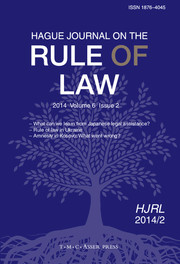Article contents
Developing Clusters of Indicators: An Alternative Approach to Measuring the Provision of Justice
Published online by Cambridge University Press: 30 September 2011
Extract
Empirical indicators are widely used in both developing and developed countries to assess the performance of justice systems. Most existing indicator initiatives base their findings on expert surveys, document reviews, administrative data, or public surveys. While each of these data sources is suited to the measurement of particular facets of justice system performance, reliance on just one or two sources of information can introduce systematic bias, distorting the results of assessments. This paper discusses the strengths and weaknesses of each of the commonly used types of indicator data and describes an approach that uses clusters of indicators drawn from multiple sources. This method can reflect the complex and multi-faceted nature of justice systems while including checks on the biases inherent in individual data sources. The paper concludes with a discussion of the strengths and drawbacks of this method compared to approaches more commonly adopted by existing indicator initiatives.
Keywords
Information
- Type
- Articles
- Information
- Copyright
- Copyright © T.M.C. Asser Press and the Authors 2011
- 6
- Cited by

